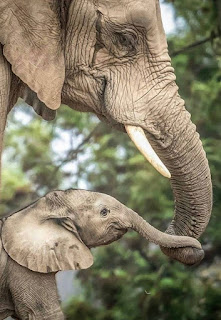COGNITIVE SKILLS OF ELEPHANT
Elephants have been observed using such ‘learned’ skills to either cleverly cross electric fences using their non-conducting tusks or if no tusks, destroying the entire fence by hurling uprooted trees on the wire or pushing down the cemented poles to disconnect the wire. These are some testimonies suggesting how elephants perhaps may be learning to solve the conundrum based on their previous noxious experiences.
.
WHY WE ARE FORGOTTEN ABOUT SOMETHING
People visiting forests feel great about being in nature. They capture some memories and photographs, and write blogs about how splendid nature is. What they forget in the due course is the compromise some of the long-ranging animals must have gone through. One such animal that needs a large roaming space and seasonal connectivity to different forests are elephants. Their movements are not just motivated for foraging, but for searching for mates, suitable habitats across seasons and resources.
MAN AND ANIMAL CONFLICT
The boundary marked by us for forests as protected often goes unnoticed by the oblivious wanderers of the wild. Let us take elephants as an example. Amid the escalating interactions between elephants and humans lie our failed attempts of facilitating the movement of these giant animals through one of their abodes to another. From an animal perspective, the trench, wall, or fences can just be a set of hurdles that they attempt to cross to reach their destiny. For a taxon of proven complex cognition, everything around them could just be a conundrum that they seek or ‘learn’ to solve.
WAY AHEAD
This is just one opportunistic instance among many anecdotes and videos that we stumble over in social media, where we see elephants ingeniously crossing the electric fences, iron rails and even trenches. Most of these videos leave us with dropped jaw, hinting to us how elephants could alter their behaviours in response to the altered habitats!
Elephants have been observed using such ‘learned’ skills to either cleverly cross electric fences using their non-conducting tusks or if no tusks, destroying the entire fence by hurling uprooted trees on the wire or pushing down the cemented poles to disconnect the wire. These are some testimonies suggesting how elephants perhaps may be learning to solve the conundrum based on their previous noxious experiences.
.
WHY WE ARE FORGOTTEN ABOUT SOMETHING
People visiting forests feel great about being in nature. They capture some memories and photographs, and write blogs about how splendid nature is. What they forget in the due course is the compromise some of the long-ranging animals must have gone through. One such animal that needs a large roaming space and seasonal connectivity to different forests are elephants. Their movements are not just motivated for foraging, but for searching for mates, suitable habitats across seasons and resources.
MAN AND ANIMAL CONFLICT
The boundary marked by us for forests as protected often goes unnoticed by the oblivious wanderers of the wild. Let us take elephants as an example. Amid the escalating interactions between elephants and humans lie our failed attempts of facilitating the movement of these giant animals through one of their abodes to another. From an animal perspective, the trench, wall, or fences can just be a set of hurdles that they attempt to cross to reach their destiny. For a taxon of proven complex cognition, everything around them could just be a conundrum that they seek or ‘learn’ to solve.
WAY AHEAD
This is just one opportunistic instance among many anecdotes and videos that we stumble over in social media, where we see elephants ingeniously crossing the electric fences, iron rails and even trenches. Most of these videos leave us with dropped jaw, hinting to us how elephants could alter their behaviours in response to the altered habitats!
Crossing the border is not as painless as it is narrated here. It comes with the challenge of risking their lives. We hear of elephants encountering humans adversely, being electrocuted while crossing the electric fence, dying while crossing the iron rails, falling and dying in the trenches. Each hurdle they cross may psychologically influence their internal states, either preparing them with skills and anticipatory responses to learn to cross or leave them hurt.
Our limited understanding of the purpose and patterns of elephants’ movements blur our desperate trials of fostering coexistence. Elephants’ successful attempts of crossing the boundary just muddle up many who are not just trying to understand the highly intelligent being, but also trying to seek a sustainable solution to retard the accelerating adverse interactions between them and us. Connecting habitats with the corridor devoid of human presence and activities may reduce elephants’ interactions with humans, lower their stress and favour their purpose of movement. Talking of conservation of animals’ with complex cognitive ability, the need is, thus, the connectivity, perhaps not just the border!


Comments
Post a Comment